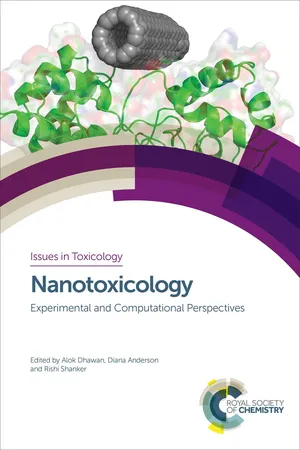
Nanotoxicology
Experimental and Computational Perspectives
- 356 pages
- English
- ePUB (mobile friendly)
- Available on iOS & Android
About this book
The rapid expansion of the nanotechnology field raises concerns, like any new technology, about the toxicity and environmental impact of nanomaterials. This book addresses the gaps relating to health and safety issues of this field and aims to bring together fragmented knowledge on nanosafety. Not only do chapters address conventional toxicity issues, but also more recent developments such as food borne nanoparticles, life cycle analysis of nanoparticles and nano ethics. In addition, the authors discuss the environmental impact of nanotechnologies as well as safety guidelines and ethical issues surrounding the use of nanoparticles. In particular this book presents a unique compilation of experimental and computational perspectives and illustrates the use of computational models as a support for experimental work. Nanotoxicology: Experimental and Computational Perspectives is aimed towards postgraduates, academics, and practicing industry professionals. This highly comprehensive review also serves as an excellent foundation for undergraduate students and researchers new to nanotechnology and nanotoxicology. It is of particular value to toxicologists working in nanotechnology, chemical risk assessment, food science, environmental, safety, chemical engineering, the biological sciences and pharmaceutical research.
Frequently asked questions
- Essential is ideal for learners and professionals who enjoy exploring a wide range of subjects. Access the Essential Library with 800,000+ trusted titles and best-sellers across business, personal growth, and the humanities. Includes unlimited reading time and Standard Read Aloud voice.
- Complete: Perfect for advanced learners and researchers needing full, unrestricted access. Unlock 1.4M+ books across hundreds of subjects, including academic and specialized titles. The Complete Plan also includes advanced features like Premium Read Aloud and Research Assistant.
Please note we cannot support devices running on iOS 13 and Android 7 or earlier. Learn more about using the app.
Information
1.1 Introduction
1.2 The Hurdles in Toxicity Evaluation of NMs
- Size: based on the material used in precursor solutions to produce NMs, properties such as solubility, transparency, absorption or emission wavelength, conductivity, melting point, colour and catalytic behaviour are changed by varying the particle size of NMs. Nanomaterials possess unique physicochemical properties due to their size; which also affects the mobility and transport behaviour of NMs.
- Composition effects: it is clear that different particle compositions lead to different physical and chemical behaviours of the material.
- Surface effects: the smaller the diameter of a spherical particle, the higher the surface-to-volume ratio and the specific surface area. This is accompanied by properties such as dispersity, conductivity, catalytic behaviour, chemical reactivity and optical properties. Therefore, more attention has to be paid to the surface material of a nanoparticle (NP) rather than its core material. When bare NMs come in contact with a heterogeneous environment, the smaller structures such as atoms, molecules or macromolecules attach to the surface of the NMs either by strong or weak interaction forces. In a biological environment, molecules such as proteins and polymers interact with the NM surface layer and form a “NM–protein corona”. It has also been shown that it is not the NMs alone, but also the corona that defines the properties of the “particle-plus-corona” compound.15,16 This makes it necessary to understand not only the behaviour of NMs but also the biological interaction environment.
- Agglomeration: agglomeration affects the surface properties of NMs and their bioavailability to the cells.
- Solubility: some NMs are reported to produce ions in soluble form, which may be toxic to the cells e.g., ZnO, CuO.
- Surface charge and dispersity: surface charge of the NMs affects the particle solubility in suspension, whereas the dispersity of NMs provides information about their tendency to agglomerate.
- Dose metric: the exposure metric for NMs has been expressed, based on mass, number or surface area. The National Institute for Occupational Safety and Health (NIOSH) recommends that the “exposure metrics other than airborne mass concentration may be a better predictor of certain lung diseases, but it was decided that existing sampling methods will report in mass concentration because the toxicological effects observed are based on a mass dose”.17 The issue of the proper metric for enumerating NPs in workplaces is still a debatable issue. As mentioned, surface area concentration has been found to correlate well, regardless of particle size, with pulmonary response. However, this may not be true for all particle types and may also be a function of the agglomeration state.
1.3 ENM Interference with Toxicity Test Methods
1.3.1 Interference of NPs with Metabolic Activity Detection Assays
Table of contents
- Cover
- Title
- Copyright
- Foreword
- Preface
- Editor Biographies
- Contents
- Chapter 1 Nanotoxicology: Challenges for Biologists
- Chapter 2 Chemical Synthesis of Nanoparticles for Diverse Applications
- Chapter 3 Synthesis of Nanoparticles for Biomedical Applications
- Chapter 4 Protocols for In vitro and In vivo Toxicity Assessment of Engineered Nanoparticles
- Chapter 5 Nanoparticles in Biomedicine and Medicine, and Possible Clinical Toxicological Application of Peripheral Lymphocytes in the Risk Assessment Process for Susceptible Disease State Individuals
- Chapter 6 Health Hazard and Risk Assessment of Nanoparticles Applied in Biomedicine
- Chapter 7 Emerging Systems Toxicology Approaches in Nanosafety Assessment
- Chapter 8 Organ-on-chip Systems: An Emerging Platform for Toxicity Screening of Chemicals, Pharmaceuticals, and Nanomaterials
- Chapter 9 Progress Towards Risk Assessment for Engineered Nanomaterials
- Chapter 10 Three-dimensional Models for In vitro Nanotoxicity Testing
- Chapter 11 Computational Modelling of Biological Responses to Engineered Nanomaterials
- Chapter 12 Computational Approaches for Predicting Nanotoxicity at the Molecular Level
- Chapter 13 Safety Guidelines: Recommendations by Various Nations
- Subject Index